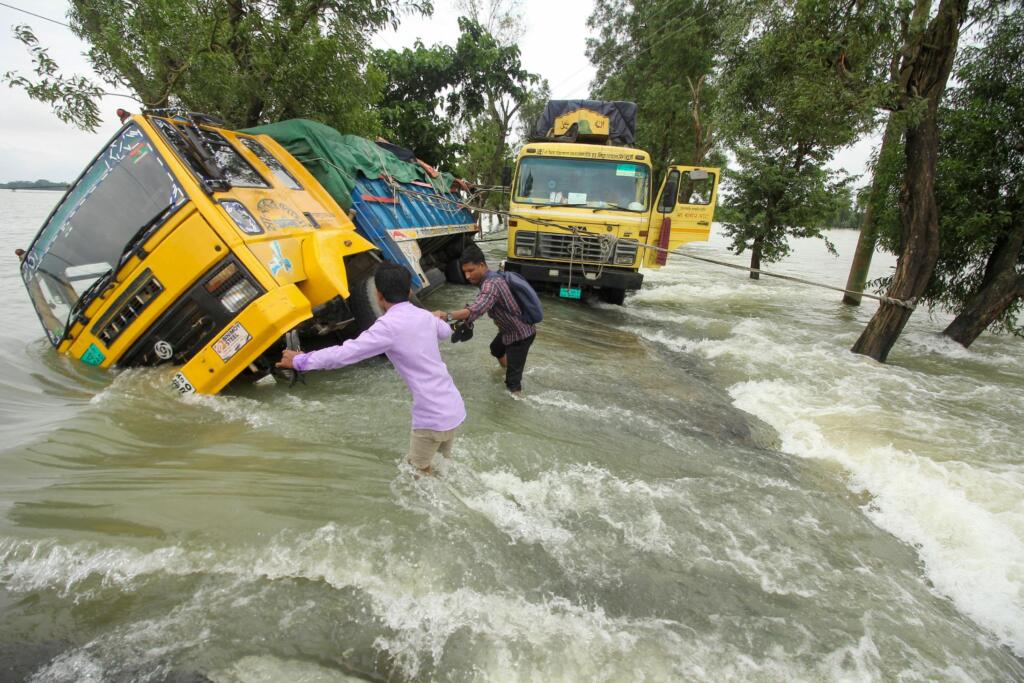Assam, a northeastern state of India, faces severe flooding each year. This year also, it faced disastrous flood. This natural disaster affects millions of people and wildlife across the region. The floods stem from various factors, both natural and human-made. Understanding these causes and their impacts is crucial for developing effective mitigation strategies. Assam’s unique geography and climate make it particularly vulnerable to flooding, necessitating a thorough examination of the issue.
The Impact of Assam’s Floods
Wildlife Loss in Assam
Assam’s rich biodiversity suffers greatly during floods. Kaziranga National Park, home to the world’s largest population of one-horned rhinos, experiences significant animal deaths. Recent floods claimed over 130 wild animals, including rare rhinos, hog deer, and other species. These losses highlight the urgent need for wildlife protection measures in Assam’s flood-prone areas.
Infrastructure Damage in Assam
Floods wreak havoc on Assam’s infrastructure. Roads, bridges, and buildings often sustain extensive damage. This destruction hinders rescue operations and relief efforts, making it challenging to reach affected areas. Assam’s government faces the ongoing task of rebuilding and reinforcing critical infrastructure to withstand future floods.
Displacement in Assam
The floods force millions of Assam’s residents to abandon their homes. Many seek shelter in relief camps, straining available resources and management capabilities. This mass displacement disrupts lives and livelihoods across the state. Assam’s authorities must continually improve their capacity to provide shelter and support to displaced populations.
Understanding the Ganges-Brahmaputra Delta
The Ganges-Brahmaputra Delta, which includes Assam, is a vast region covering over 105,000 square kilometers. This area’s complex river networks create a unique landscape. However, the delta’s geography also makes it highly susceptible to annual flooding. Assam’s position within this delta contributes significantly to its flood vulnerability.
Factors Contributing to Flood Vulnerability
Natural Causes
Heavy rainfall during monsoons is a primary cause of flooding in Assam. The region’s rivers, including the Brahmaputra, have dynamic, shifting courses prone to erosion. Tectonic activity in this seismically active zone can trigger landslides and alter river paths. Tidal influences and cyclones further compound the flooding risk in Assam and the broader delta region. These natural factors make Assam’s flood management a complex challenge.
Human-Induced Factors
Deforestation in Assam and surrounding areas increases soil erosion and river sediment. Encroachment on floodplains reduces natural drainage. Inadequate infrastructure and poor urban planning exacerbate flood impacts in Assam’s cities and towns. Addressing these human-induced factors is crucial for long-term flood mitigation in Assam.
Mitigating Flood Risks in Assam
To address Assam’s flood challenges, several strategies can be implemented:
1. Early Warning Systems: Develop advanced alert systems to warn Assam’s communities of impending floods. These systems can significantly reduce loss of life and property damage.
2. Eco-Restoration in Assam: Undertake reforestation and wetland conservation to enhance natural drainage. Restoring Assam’s ecosystem can help absorb excess water and reduce flood severity.
3. Infrastructure Improvement: Invest in flood-resistant structures and better drainage systems across Assam. This includes reinforcing embankments and upgrading urban water management systems.
4. Community Engagement: Involve Assam’s local communities in flood preparedness and response planning. Educating residents about flood risks and safety measures is essential for building resilience.
5. Climate-Resilient Agriculture: Promote farming practices adapted to Assam’s flood-prone conditions. This can help protect livelihoods and ensure food security during flood seasons.
NDMA Guidelines for Flood Preparedness
The National Disaster Management Authority provides essential guidelines for flood preparation, which are particularly relevant for Assam:
Preparing Homes in Assam: Avoid building in flood-prone areas. Elevate crucial home systems and install protective measures. Assam residents should consider flood-proofing their homes where possible.
When Floods Threaten Assam: Stay informed through media. Be ready to move to higher ground quickly. Assam’s authorities should ensure clear communication channels for flood warnings.
Evacuation in Assam: Secure homes before leaving. Avoid walking or driving through floodwaters. Assam’s disaster response teams should be prepared to assist with safe evacuations.
Assam’s Unique Challenges
Assam faces unique challenges in flood management due to its geographical location and socio-economic conditions. The state’s heavy reliance on agriculture makes flood impacts particularly devastating for rural communities. Additionally, Assam’s diverse terrain, ranging from floodplains to hills, requires varied flood management approaches.
Future Outlook for Assam
As climate change intensifies, Assam may face more frequent and severe flooding. This underscores the need for long-term, sustainable flood management strategies. Assam’s government and communities must work together to build resilience and adapt to changing environmental conditions.
Conclusion
Addressing Assam’s annual floods requires a multifaceted approach. By combining improved infrastructure, sustainable practices, community involvement, and adherence to safety guidelines, Assam can better manage its flood risks. While some factors are unavoidable, proactive measures can significantly reduce the impact of floods on Assam’s people, wildlife, and economy. The state’s future depends on effective flood management and adaptation strategies tailored to Assam’s unique environmental and social context.
